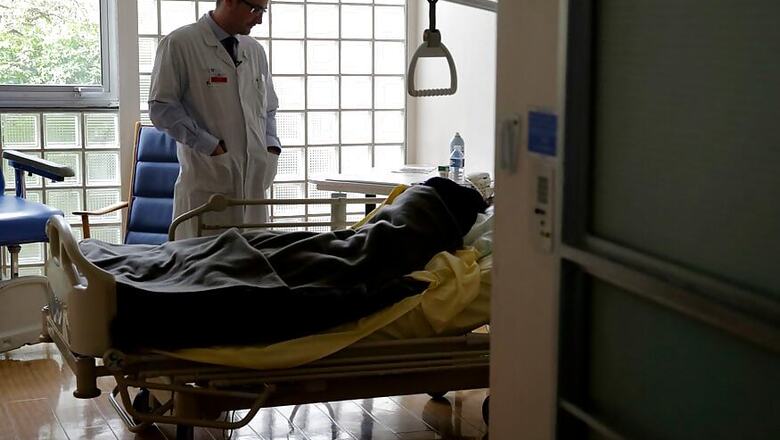
views
New Delhi: Twenty six children have died of diphtheria - a disease which has disappeared from most of the world, and one for which India introduced a vaccine as a part of routine immunisation as early as 1978 - in the national capital so far.
The resurgence across the country shows that the vaccination is not reaching everyone.
Inadequate immunisation, patchy coverage of booster doses and the unavailability of accessible drugs have combined to give India the dubious title of being the world leader in diphtheria cases.
Diptheria is a devastating disease that resulted in the death of millions of children before vaccines were introduced. Highly infectious, it shows up initially as a sore throat, leading to difficulty in breathing. Severe cases see the toxin released by the bacteria killing cells in the throat. The debris from this results in the development of a wing-shaped grey membrane which disrupts breathing. If the child isn't treated quickly, it spreads through the blood. The heart and kidneys are damaged and death follows.
But as vaccinations and sanitation improved, the disease disappeared from most of the world. In Colombia, for instance, which had over 11,000 cases from 1980-1985, there have been no cases since 2005, as per the World Health Organization.
In 2012, with a little over 2,500 cases - the lowest since 1999, India seemed to be winning the battle against the disease. But by 2016, this increased to 3,380 cases - 47.63% of the world's total. By 2017, this increased to 5,293 cases - 60% of the total cases in the world.
Inadequate immunisation
As per the Universal Immunisation Programme (UIP) in India, all children below one year get three doses of Diphtheria-Tetanus-Pertussis (DTP) vaccine. This is followed by two booster doses between the ages of 1-2 years and 5-6 years. The coverage for the first three doses is inadequate in 80% of the country, while data suggest that coverage of booster doses is also patchy.
The difference between states with poor primary immunisation and others is reflected clearly in each of India's outbreaks. So, for instance, Bihar which has historically had a shoddy record of primary immunisation sees 41% of its cases in children below the age of five, as per a WHO report. In Kerala, which has high rates of immunisation, 74% of the cases were in children above the age of 10, suggesting poor rates of children getting the booster doses. In fact, some countries, including the United States, have introduced boosters for adults and adolescents.
The Maharishi Valmiki Infectious Diseases Hospital in Delhi, where 24 children have died, has got the bulk of its cases from Haryana and Uttar Pradesh. Data from the WHO suggest that both states have 53% of its cases in the 5-10 age group. The WHO report notes that the age distribution is "surprising", while Haryana's vaccination coverage requires improvement.
Access to drugs
Delay in procurement of the antitoxins, for the treatment of diptheria, was cited as a key factor in the first 21 deaths of the children at Delhi's Maharishi Valmiki Infectious Diseases Hospital. The North MCD allocated Rs 38 crore for procurement of the Diphtheria Antitoxin (DAT) or Anti-diptheria serum (ADS). But this pattern of loss of human life, due to unavailability of medicines follows a grim pattern across the country.
As diptheria cases decreased globally by the 1950s, with countries scaling up their immunisation programmes, the global market for the DAT disappeared. With the disease disappearing, there simply wasn't enough demand for drug manufacturers to produce the life-saving drug. In India, there are a handful of companies who manufacture the drug. But experts point out, the medicines are not regularly manufactured.
Yogesh Jain, a public health physician at Jan Swasthya Sahyog, Chhattisgarh said, "This is a drug that the hospital needs to have before the patient comes in. The disease spreads very quickly. So hospitals need to have a ready stock. But the problem is one of demand and supply. The shortage of the medicines for a neglected disease like this needs to be addressed and pharmaceutical companies should be commissioned by the government to produce the medicine."
Why does it matter?
In the 1990s, a diptheria epidemic in the former Soviet Union made 1,57,000 people ill and killed 5,000 people. This was a result of a change in the vaccination schedule, made worse by the prevailing socio-economic instability. More recently, the disease spread through Rohingya refugee camps in Bangladesh. Doctors suspected that overcrowding and poor immunisation was the cause, with at least 2,526 suspected cases and 27 deaths as of December 2017.
A doctor with the Maharishi Valmiki Infectious Diseases Hospital explained that geographic concentrations were important to investigate to understand the root causes. "So in the past two years, we have seen a number of cases from specific areas of Ghaziabad and Meerut. In fact, the number of cases has increased this year. It is important for the state health department and the Centre to understand the root cause. It could be poor immunisation or lack of awareness. But that needs to be identified and addressed."


















Comments
0 comment